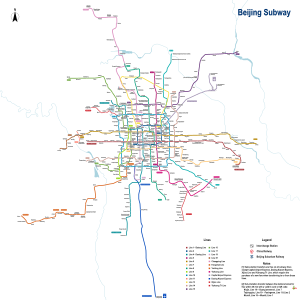
Back مترو بكين Arabic پکن متروسو AZB Пекінскі метрапалітэн Byelorussian Пэкінскі мэтрапалітэн BE-X-OLD Пекински метрополитен Bulgarian বেইজিং সাবওয়ে Bengali/Bangla Metro de Pequín Catalan Metro v Pekingu Czech U-Bahn Peking German Μετρό Πεκίνου Greek
| Beijing Subway | |||||||
|---|---|---|---|---|---|---|---|
 Logo of Beijing Subway | |||||||
 A line 13 train leaving Huoying station | |||||||
| Overview | |||||||
| Native name | |||||||
| Chinese name | |||||||
| Simplified Chinese | 北京地铁 | ||||||
| Traditional Chinese | 北京地鐵 | ||||||
| |||||||
| Owner | Beijing Municipal Government | ||||||
| Locale | Beijing & Langfang, Hebei | ||||||
| Transit type | Rapid transit | ||||||
| Number of lines | 27 | ||||||
| Number of stations | 490[1] | ||||||
| Daily ridership | 10.544 million (2018 daily avg.)[2] 13.7538 million (12 July 2019 record)[3] | ||||||
| Annual ridership | 3.8484 billion (2018)[2] | ||||||
| Website | bjsubway.com mtr.bj.cn bjmoa.cn | ||||||
| Operation | |||||||
| Began operation | 15 January 1971 | ||||||
| Operator(s) |
| ||||||
| Character | Underground, at grade and elevated | ||||||
| Number of vehicles | 6,173 Revenue Railcars (2019)[4] | ||||||
| Technical | |||||||
| System length | 836 km (519 mi)[1] | ||||||
| Track gauge | 1,435 mm (4 ft 8+1⁄2 in) standard gauge | ||||||
| Electrification |
| ||||||
| |||||||
The Beijing Subway is the rapid transit system of Beijing Municipality that consists of 27 lines including 22 rapid transit lines, two airport rail links, one maglev line and 2 light rail lines, and 490 stations.[1] The rail network extends 836 km (519 mi)[1] across 12 urban and suburban districts of Beijing and into one district of Langfang in neighboring Hebei province. With 3.8484 billion trips delivered in 2018,[2] an average of 10.544 million trips per day,[2] the Beijing Subway is the world's busiest metro system. Single-day ridership set a record of 13.7538 million on July 12, 2019.[3] Being 836 kilometres (519 mi) in system length, the Beijing Subway is the longest metro system by route length, surpassing the Shanghai Metro in December 2023.
The Beijing Subway opened in 1971 and is the oldest metro system in mainland China and on the mainland of East Asia. Before the system began its rapid expansion in 2002, the subway had only two lines. The existing network still cannot adequately meet the city's mass transit needs. Beijing Subway's extensive expansion plans call for 998.5 km (620.4 mi)[5] of lines serving a projected 18.5 million trips every day when Phase 2 Construction Plan finished (around 2025).[6][7][8] The most recent expansion came into effect on December 30, 2023, with the openings of extensions to Line 11, Line 16, and Line 17.
- ^ a b c d "地铁19号线剩余4站明日试运营!新宫至牡丹园只需半小时". July 29, 2022. Archived from the original on July 29, 2022.
至此,本市城市轨道交通运营总里程783公里、车站463座
- ^ a b c d "2018年统计报告". Archived from the original on April 4, 2020. Retrieved April 9, 2019.
- ^ a b "北京轨道交通全路网日客运量再创新高 超1375万人次". July 13, 2019.
- ^ "北京市2019年国民经济和社会发展统计公报".
- ^ 未来五年再建12条地铁. September 29, 2015. Archived from the original on March 12, 2016. Retrieved October 2, 2015.
- ^ Li Song (李松). "Beijing's subway is going full bore - China - Chinadaily.com.cn". www.chinadaily.com.cn. Retrieved January 19, 2017.
- ^ 北京2020年轨道交通线路预计将达1000公里左右. www.chinanews.com.cn (in Simplified Chinese). December 30, 2010.
- ^ Xin, Dingding (July 31, 2012). "Experts fear subway costs could go off the rails". China Daily.
© MMXXIII Rich X Search. We shall prevail. All rights reserved. Rich X Search
